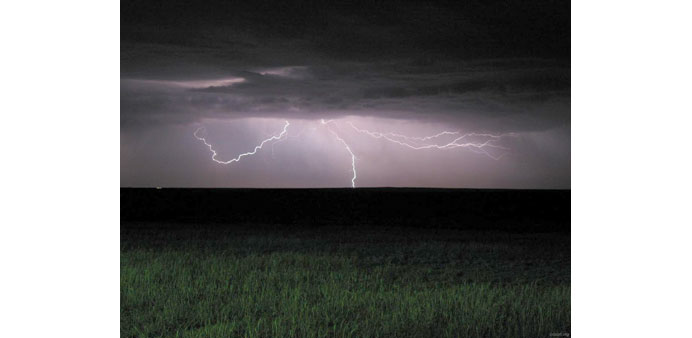By Steff Gaulter
An impressive electrical display has been illuminating the skies above the UK. On July 18, 3,000 lightning strikes were recorded in just two hours. It was generated by what’s known as a Spanish Plume, which are responsible for some of the most active thunderstorms that are seen in northwest Europe. As their name suggests, part of the trigger of these storms is the weather over the Iberian Peninsula.
At this time of year, temperatures soar over Spain and Portugal. In July, the average maximum temperature in Madrid is 31.2C (88F). This is hot enough for most people, but over the past few days, the weather has been getting far hotter than that. The last time that temperatures were below the average was on July 11; since then on some days they’ve climbed as high as 38C (100F).
The geography of the region also plays an important role in the weather. Spain and Portugal sit together on what’s known as the Iberian Peninsula, which is an elevated landmass in the southwest of Europe. It is surrounded on all sides by water, except for a 450km (280 mile) stretch where it links to France. Its vast interior plateau, with Madrid at its centre, extends over 210,000 sq km (81,000 square miles) and has an average elevation of 2,165ft (660m).
Often the hot air can sit over Spain for days on end, but on July 16, the winds started to draw the air towards the north. This air was swept off the Spanish plateau, and drifted high above the ground, invisibly over France and the UK.
At the same time, the air was warming over northwestern Europe. Warm, humid air was being blown across the UK from the Bay of Biscay. This air was at ground level, and temperatures which had been in the mid-20s C, rose to 30C (86F) on July 18. The humidity didn’t help either, with the air feeling close and sticky, particularly at night. At this point, the air from Spain was still sitting invisibly on top of the humid air, and had it not been for one other twist in the weather, no one need have even known that it was there.
As the temperatures soared across northwestern Europe, a weather system approached from the Atlantic. As this system approached, it encouraged the air ahead of it to rise. This enabled the air from western France and the air from Spain to mix, which they did with explosive results.
A Spanish Plume can only happen in the summer months, and the set up requires a number of factors to happen at the same time. This means that it usually strikes only once or twice a year, but it can generate some of the most powerful thunderstorms that we see in the UK.
Not only can Spanish plumes give impressive lightning displays, as they did in this case, but they can also produce gusty winds, damaging hail and have even been known to trigger tornadoes.
The recent Spanish Plume sparked a number of fires, one of which completely destroyed a home in the West Midlands, and the storms forced the cancellation of some flights. The impressive displays of lightning also ensured that the weather made front page news on all the national newspapers, which goes to show that lightning isn’t as common in the UK as it might be.
As you might expect, the number of lightning strikes is not evenly distributed across the globe. The north and south poles have the fewest lightning strikes, and the Tropics have the most. Central Africa is a particular hot spot for thunderstorms, with the small village of Kifuka in the Democratic Republic of Congo being in the Guinness Book of Records as the place which sees the most lighting. Every year the village sees 158 strikes per square kilometre.
The reason for the frequency of lightning is due to the location; Kifuka is just 300km south of the equator in a tropical wet climate. This means that it rains almost every day of the year, with much of the rain originating from thunderstorm clouds. The village is 3200ft (970m) above sea level and scientists have suggested that the additional trigger for the thunderstorms is that this is the first mountain range which the humid air reaches as it is drawn in from the Atlantic. As the air is forced over the mountains, the extra uplift is enough to make Kifuka the lightning capital of the world.
Another region which is a magnet for lightning is Catatumbo in Venezuela. Lightning occurs around 150 nights of the year and up to 10 hours per night. During one of the displays, the lightning is so frequent that there can be up to 280 strikes per hour. Some sailors even claim it is a useful navigational aid.
The lightning occurs over the mouth of Catatumbo River, where it empties into Lake Maracaibo. The lake is surrounded by mountains which influence the wind patterns, encouraging the air to converge. This forces the air to rise and triggers the thunderstorms. These storms form night after night, in exactly the same location.
Catatumbo is now becoming very popular with tourists, who enjoy the crash, bang, wallop of nature. For the locals, it’s simply something that has always happened and the thunder doesn’t even disturb their sleep anymore. They are more bemused by the tourists.



